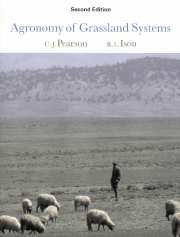Book contents
- Frontmatter
- Contents
- Preface
- 1 Overview: perspectives on grassland systems
- 2 The emergence of grassland systems
- 3 Generation
- 4 Vegetative growth
- 5 Flowering and seed production
- 6 Mineral nutrition
- 7 Herbage quality and animal intake
- 8 Grassland – animal interactions and management
- 9 Grassland systems design
- References
- Index
5 - Flowering and seed production
Published online by Cambridge University Press: 05 June 2012
- Frontmatter
- Contents
- Preface
- 1 Overview: perspectives on grassland systems
- 2 The emergence of grassland systems
- 3 Generation
- 4 Vegetative growth
- 5 Flowering and seed production
- 6 Mineral nutrition
- 7 Herbage quality and animal intake
- 8 Grassland – animal interactions and management
- 9 Grassland systems design
- References
- Index
Summary
Stability through persistence is a desired feature of natural grasslands and sown pasture. This is particularly true in grasslands comprised of one or more species that are intended to remain productive for several years. Reproductive development and the subsequent building up of seeds in the soil are essential for the persistence of grasslands based on annuals and they are an important means of providing new seedlings in some perennial grasslands (Fig. 3.3). An understanding of the factors that control flowering and subsequent seed production is desirable for (i) delineating environments in which sown selections are capable of producing seed for regeneration; (ii) adopting agronomic and grazing strategies to ensure successful flowering, seed production and sustained animal productivity; (iii) selecting sites for commercial production of seed, and (iv) enabling farmers, conservationists, etc. to obtain reliable seed supplies in terms of quantity, quality and price.
The phases encompassed in reproductive development frequently overlap (Fig. 4.1); their duration varies depending on their sensitivity to environment. If we understand the phases involved and their flexibility, we may be better able to manage flowering and seed production. This may be done by adjusting the rate and duration of developmental phases so long as these changes are free of compensatory changes in the rate or duration of other phases.
Seed is the product of interest: the first component of seed yield potential is the density of bud sites (plants per unit area × tillers or branches per plant, Chapter 4). Bud density is related to the length of the vegetative phase and thus to the timing of floral initiation (Fig. 4.1).
- Type
- Chapter
- Information
- Agronomy of Grassland Systems , pp. 83 - 98Publisher: Cambridge University PressPrint publication year: 1997



